List of Star Trek: The Original Series writers
- View history
This is a list of writers for the original Star Trek television series sorted by the amount of episodes written. Collaborations are marked with dashes. (-) Contributions, pseudonyms and episode numbers are noted in parenthesis.
- 1 13 episodes
- 2 12 episodes
- 3 10 episodes
- 4 4 episodes
- 5 3 episodes
- 6 2 episodes
- 7 1 episode

13 episodes [ ]
- "Arena" (S01E18) (Teleplay)
- "Space Seed" (S01E22) (Teleplay - with Carey Wilber)
- "A Taste of Armageddon" (S01E23) (Teleplay - with Robert Hamner)
- "The Devil in the Dark" (S01E25)
- "Errand of Mercy" (S01E26)
- "The Apple" (S02E05) (Teleplay - with Max Ehrlich)
- "Metamorphosis" (S02E09)
- "A Piece of the Action" (S02E17) (Teleplay - with David P. Harmon)
- "Bread and Circuses" (S02E25) - with Gene Roddenberry
- "Spock's Brain" (S03E01) (as Lee Cronin)
- "Spectre of the Gun" (S03E06) (as Lee Cronin)
- "Wink of an Eye" (S03E11) (Story, as Lee Cronin)
- "Let That Be Your Last Battlefield" (S03E15) (Story, as Lee Cronin)
12 episodes [ ]
- "Charlie X" (S01E02) (Story)
- "Mudd's Women" (S01E06) (Story)
- "The Menagerie, Part I" (S01E11)
- "The Menagerie, Part II" (S01E12)
- "The Return of the Archons" (S01E21) (Story)
- "A Private Little War" (S02E19) (Teleplay)
- "The Omega Glory" (S02E23)
- "Bread and Circuses" (S02E25) - with Gene L. Coon
- "Assignment: Earth" (S02E26) (Story - with Art Wallace)
- "The Savage Curtain" (S03E22) (Teleplay - with Arthur Heinemann) / (Story)
- "Turnabout Intruder" (S03E24) (Story)
10 episodes [ ]
- "Charlie X" (S01E02) (Teleplay)
- "Tomorrow Is Yesterday" (S01E19)
- "This Side of Paradise" (S01E24) (Teleplay) / (Story - with Jerry Sohl)
- "Journey to Babel" (S02E10)
- "Friday's Child" (S02E11)
- "By Any Other Name" (S02E22) (Teleplay - with Jerome Bixby)
- "The Ultimate Computer" (S02E24) (Teleplay)
- "The Enterprise Incident" (S03E02)
- "That Which Survives" (S03E17) (Story, as Michael Richards)
- "The Way to Eden" (S03E20) (Story, as Michael Richards - with Arthur Heinemann)
4 episodes [ ]
- "The Changeling" (S02E03)
- "Patterns of Force" (S02E21)
- "Elaan of Troyius" (S03E13)
- "That Which Survives" (S03E17) (Teleplay)
- "Mirror, Mirror" (S02E04)
- "By Any Other Name" (S02E22) (Teleplay - with D. C. Fontana) / (Story)
- "Day of the Dove" (S03E07)
- "Requiem for Methuselah" (S03E19)
3 episodes [ ]
- "What Are Little Girls Made Of?" (S01E07)
- "Catspaw" (S02E07)
- "Wolf in the Fold" (S02E14)
- "The Corbomite Maneuver" (S01E10)
- "This Side of Paradise" (S01E24) (Story, as Nathan Butler - with D. C. Fontana)
- "Whom Gods Destroy" (S03E14) (Story - with Lee Erwin)
- "The Galileo Seven" (S01E16) (Teleplay - with S. Bar-David) / (Story)
- "Let That Be Your Last Battlefield" (S03E15) (Teleplay)
- "The Cloud Minders" (S03E21) (Story - with David Gerrold)
- "The Gamesters of Triskelion" (S02E16)
- "The Paradise Syndrome" (S03E03)
- "The Cloud Minders" (S03E21) (Teleplay)
- "Wink of an Eye" (S03E11) (Teleplay)
- "The Way to Eden" (S03E20) (Teleplay) / (Story - with D. C. Fontana)
- "The Savage Curtain" (S03E22) (Teleplay - with Gene Roddenberry)
2 episodes [ ]
- "Mudd's Women" (S01E06) (Teleplay)
- "I, Mudd" (S02E08)
- "Dagger of the Mind" (S01E09)
- "The Galileo Seven" (S01E16) (Teleplay - with Oliver Crawford)
- "Balance of Terror" (S01E14)
- "The Squire of Gothos" (S01E17)
- "Shore Leave" (S01E15)
- "Amok Time" (S02E01)
- "Court Martial" (S01E20) (Teleplay - with Don M. Mankiewicz)
- "Operation: Annihilate!" (S01E29)
- "The Deadly Years" (S02E12)
- "A Piece of the Action" (S02E17) (Teleplay - with Gene L. Coon) / (Story)
- "Obsession" (S02E13)
- "Assignment: Earth" (S02E26) (Teleplay) / (Story - with Gene Roddenberry)
- "The Trouble with Tribbles" (S02E15)
- "The Cloud Minders" (S03E21) (Story - with Oliver Crawford)
- "Is There in Truth No Beauty?" (S03E05)
- "All Our Yesterdays" (S03E23)
1 episode [ ]
- George Clayton Johnson - "The Man Trap" (S01E01)
- Samuel A. Peeples - "Where No Man Has Gone Before" (S01E03)
- John D. F. Black - "The Naked Time" (S01E04)
- Richard Matheson - "The Enemy Within" (S01E05)
- Adrian Spies - "Miri" (S01E08)
- Barry Trivers - "The Conscience of the King" (S01E13)
- Fredric Brown - "Arena" (S01E18) (Story)
- Don M. Mankiewicz - "Court Martial" (S01E20) (Teleplay - with Steven W. Carabatsos) / (Story)
- Boris Sobelman - "The Return of the Archons" (S01E21) (Teleplay)
- Carey Wilber - "Space Seed" (S01E22) (Teleplay - with Gene L. Coon) / (Story)
- Robert Hamner - "A Taste of Armageddon" (S01E23) (Teleplay - with Gene L. Coon) / (Story)
- Don Ingalls - "The Alternative Factor" (S01E27)
- Harlan Ellison - "The City on the Edge of Forever" (S01E28)
- Gilbert Ralston - "Who Mourns for Adonais?" (S02E02)
- Max Ehrlich - "The Apple" (S02E05) (Teleplay - with Gene L. Coon( / (Story)
- Norman Spinrad - "The Doomsday Machine" (S02E06)
- Robert Sabaroff - "The Immunity Syndrome" (S02E18)
- Jud Crucis - "A Private Little War" (S02E19) (Story)
- John Kingsbridge - "Return to Tomorrow" (S02E20)
- Laurence N. Wolfe - "The Ultimate Computer" (S02E24) (Story)
- Edward J. Lakso - "And the Children Shall Lead" (S03E04)
- Rik Vollaerts - "For the World Is Hollow and I Have Touched the Sky" (S03E08)
- Judy Burns & Chet Richards - "The Tholian Web" (S03E09)
- Meyer Dolinsky - "Plato's Stepchildren" (S03E10)
- Joyce Muskat - "The Empath" (S03E12)
- Lee Erwin - "Whom Gods Destroy" (S03E14) (Teleplay) / (Story - with Jerry Sohl)
- George F. Slavin & Stanley Adams - "The Mark of Gideon" (S03E16)
- Jeremy Tarcher & Shari Lewis - "The Lights of Zetar" (S03E18)
- Arthur Singer - "Turnabout Intruder" (S03E24) (Teleplay)

Competitions
The great tv writers: gene roddenberry.
By Martin Keady · June 16, 2020
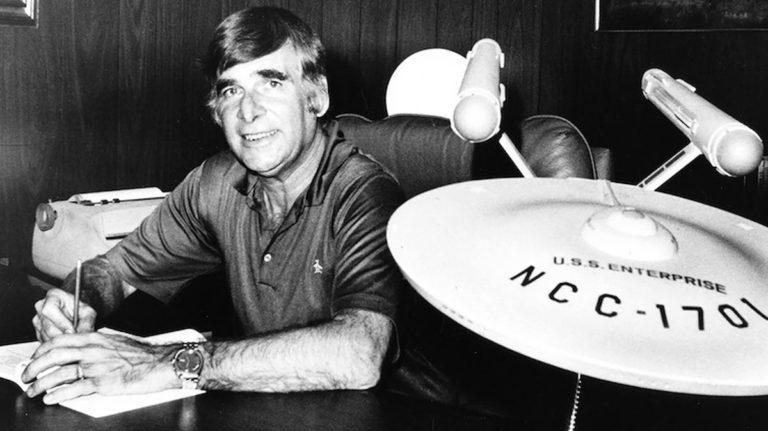
Eugene Wesley Roddenberry (August 19, 1921 – October 24, 1991) was an American television screenwriter, producer and creator of the original Star Trek television series, and its first spin-off The Next Generation . Suffice it to say, he was one of the most successful writers of his day.
I’m not a Trekkie myself, so the first time that I heard the name “Gene Roddenberry” was in Frasier , specifically the episode “Star Mitzvah”, whose title is a clue to the fact that it is something of a homage to Star Trek , the legendary sci-fi show that Roddenberry had created.
In “Star Mitzvah”, Frasier is due to attend his son Freddie’s bar mitzvah and wants to pay tribute to him in Hebrew. However, because he himself is not Jewish (Freddie is Jewish through his mother, Frasier’s ex-wife Lilith), Frasier enlists the help of Noel, a devout Trekkie, to teach him the Hebrew he needs. Unfortunately, because Frasier does not hold up his end of the bargain – namely securing the autograph of an actor who had appeared in one of the numerous spin-offs from Star Trek – Noel decides to wreak a terrible revenge by teaching him Klingon instead of Hebrew. In typical Frasierian fashion, Noel learns all too late that Frasier has made amends by buying him a wig that Joan Collins had worn during a guest appearance in the original Star Trek series. He tries to warn Frasier before he gives his speech, leading to this marvellous exchange with Roz (Frasier’s producer, who Noel is in love with):
“Noel: I’ve got to call him before he delivers his speech.
Roz: You taught him dirty words in Hebrew, didn’t you?
Noel: Uh, not quite. They’re the same words, but they’re in Klingon.
Roz: From Star Trek? That’s not even real.
Noel: It’s the fastest growing language on the planet! This is what you people don’t understand. [becoming passionate] A man named Gene Roddenberry had a vision…
Roz: CALL HIM!”
Star Mitzvah is one of the few truly great Frasier episodes in the show’s three-season-long decline between Niles and Daphne finally getting together (which robbed Frasier of much of its comic tension) and the triumphant last season that gave the show the send-off it deserved. And this exchange between Noel and Roz is the best example of how, throughout the entire 11 seasons of Frasier , the greatest sitcom ever frequently referred to and often even paid tribute to Star Trek , a TV series from the 1960s that did not run for nearly as long but none the less exerted an even greater cultural influence. Noel is right: Gene Roddenberry did indeed have a “vision” when he created Star Trek . In fact, for many Trekkies (and even the odd non-Trekkie such as myself), he is the man who put the “vision” – in the sense of having a grand idea or view – in television.
As Noel and every other self-respecting Trekkie surely knows, Eugene Wesley Roddenberry (to give the great man his full name) was born in El Paso, Texas, in 1921, but his family soon moved to Los Angeles, where his father worked as a policeman. It is telling that Roddenberry’s own father was literally a figure of authority (exactly like Frasier’s father, who was another policeman), as this may have planted the seed early on in his mind about the literally singular importance of a commander or leader. Indeed, he himself evolved into such a commanding, authoritative presence when he became a pilot in the US Army Air Forces and flew nearly 90 combat missions during WWII.
Roddenberry continued to fly after the war, working as a commercial pilot for Pan Am, until he suffered his third plane crash (following two during the war) when his plane came down in the Syrian desert during a long-haul flight. Although he personally was not responsible and indeed actually dragged some passengers to safety from the wreckage, several people were killed and the experience seems to have ended his flying career. Instead, having become the rarest of pilots – one who survives a hat-trick of crashes – he appears to have decided that from then on he would soar imaginatively rather than physically, by pursuing his long-held ambition to become a writer.
First, however, he had to continue making a living and so he literally followed in his father’s footsteps and became a police officer in Los Angeles. Fortunately, although he began in the traffic division, helping to oversee LA’s network of super-highways, Roddenberry was soon transferred to “The Newspaper Unit”. Although this sounds like the title of a James Ellroy novel (a spin-off from LA Confidential , perhaps), it was in fact the public information – or publicity – division of the LA police, probably the first of its kind in the world but entirely fitting for a city in which everyone was involved in generating (or preventing) publicity of some kind.
Roddenberry was extremely fortunate, because his stint in the public information division not only enabled him to become a speechwriter for the Chief of Police (again, only in Los Angeles would the chief of police have had a speechwriter at this time) but it literally brought him into contact with the new and burgeoning medium of the day – television. As TV began to boom in US in the late 1940s and early 1950s, with mass ownership of TV sets, cop shows soon became one of its staples and consequently various production companies and directors began approaching the LAPD for assistance, to ensure the verisimilitude of their product. As a result, Roddenberry first became a technical adviser to these companies and directors, on shows such as Mr. District Attorney (a TV version of an already popular radio drama), then a contributing scriptwriter (initially writing under the alias of “Robert Wesley”) and finally a full-blown television writer. In the end, because he was increasingly unable to perform the two very different jobs of policeman and TV scriptwriter, he finally quit the police in 1956 and became a full-time writer.
It would be an entire decade before Star Trek first hit the TV screens of America and in that time Roddenberry, like so many of the great TV writers who were to follow him, wrote for numerous television programmes of wildly varying quality. His military experience proved invaluable on his first major job, writing for The West Point Story , a “title-story” (i.e. the title is the story) about the famous military academy, and even this early on his career he was obviously prolific, as he apparently wrote about a third of all the scripts for the show during its two-season run. However, many of the other programmes that he wrote for throughout the first half of the 1960s, from Hawaii Passage (a drama set on a cruise ship) to Have Gun – Will Travel (a Western drama), were not nearly as successful. Nevertheless, the money was good, even if the shows themselves often were not.
Roddenberry finally got the chance to create his own show and draw on his own experience as both a former pilot and a former policeman in 1963, when he created The Lieutenant , a series about a young officer of that rank who is assigned his first command at the height of the Cold War, when Americans genuinely feared that a Soviet attack or even invasion was imminent. It was not a big hit – in fact, it was cancelled after just one series – but it was none the less invaluable. First, it proved to Roddenberry that he could create his own series (however short-lived); secondly, it allowed him to examine the idea of command or leadership that had been so important to him throughout his whole life, from being the son of a policeman to commanding men in the air and on the ground; and, finally, at around this time he also came up with the idea that would change both his own life and the still-new medium that he was writing in. That idea, of course, was for a show called Star Trek .
The genesis of Star Trek can be traced back through Roddenberry’s earlier television writing, even on shows that never actually made it to the small screen. Before he had begun work on The Lieutenant , he had seen a film, Master of the World (1961), which was based on a classic Jules Verne novel, about an airship that had travelled around the globe, and had thought that it could provide the basis for a television series. The idea came to nothing originally, but after The Lieutenant was cancelled, partly because Roddenberry had run into difficulties when writing a script about racial tensions in the military, he returned to it. However, rather than keep the idea earthbound, as it were, he decided to take it into space – literally. So, in 1964 he wrote a pitch or outline document and registered his idea with the Writers Guild of America. Before he had even written a pilot or spec script, he called the show Star Trek , and with that two-word title he effectively created a television series that would not only outgrow television and indeed other story-telling media (particularly cinema) but expand into and directly influence the wider culture, both in America and around the world, in a way that Roddenberry himself surely could never have imagined.
As is often the case with any kind of trek or journey, the first few steps on Roddenberry’s quest to create Star Trek were faltering, to say the least. He shopped the idea and the outline around various studios and production companies, and even had to shelve it briefly while he worked on other shows, but finally it found a home at NBC, one of the three main US TV networks. The first ever episode was broadcast on 8 September 1966, but just as Roddenberry had struggled to sell the show in the first place, now it struggled to find an audience. Ratings were low initially and barely recovered during the first series. Nevertheless, despite the widespread belief that the original Star Trek television series was cancelled virtually immediately, it ran for three series and nearly 80 episodes, which would be a good run now in the 21 st century but was exceptionally long for a non-hit series in the 1960s. However, despite this investment by the network, Star Trek failed to capture a widespread audience and it was finally cancelled in 1968.
There are many theories, especially among Trekkies themselves, as to why Star Trek enjoyed its spectacular, indeed unprecedented, rebirth after the relative failure of the original series. The most popular is that the first ever moon landing in 1969, which was broadcast live around the world and remains even today arguably the single greatest and most important broadcast in the history of television, stimulated an appetite for science fiction in general and for stories about space travel in particular that had never existed before. If that was the case, the fact that actual manned space travel did not go any further than the moon and has still not done so today, more than a half-century on, may have created an appetite for something that could only be sated by art or entertainment, rather than reality itself, and Star Trek effectively filled that void.
Another theory is that although the initial audiences for Star Trek were relatively small, the members of those audiences were devoted to the show in a way that had not really been seen before, and arguably has never been seen since, or at least not until the development of social media in the early 21 st century. Throughout its initial three-season run, Star Trek was in perpetual danger of being cancelled, but one of the reasons why it survived was that both individual fans and fan groups organised letter-writing campaigns to NBC demanding that the show continue. That devotion to the show led to avid fans of the series, such as Frasier’s Noel more than thirty years later, being called “Trekkies”, which was originally regarded as a put-down but soon became a badge of honour.
Whatever the actual reason for it, there is absolutely no doubt whatsoever that after the original series was cancelled repeats or re-runs of Star Trek began to attract far bigger audiences than had ever been the case when the series was first shown. Those repeats or re-runs led, in turn, to fans’ conventions and other events that celebrated the original show, and throughout the 1970s Star Trek became one of the most widely syndicated TV shows around the world. Overseas audiences, who were largely unaware that the show had supposedly been a flop in America the first time around, added to the burgeoning US audiences. Finally, by the time that the extraordinary success of Star Wars (1977) officially ushered in “The Age of Sci-Fi” (the cultural moment that we are still living in today and conceivably will be for the rest of human existence), the old TV show whose title sounded very similar to Star Wars – Star Trek – was becoming a fully-fledged cultural phenomenon.
While all this was going on throughout the 1970s, Roddenberry himself was experiencing an extremely difficult decade. Having risen relatively quickly from being a humble police officer to a seemingly successful television writer and producer, he then experienced a downturn after the original run of Star Trek was deemed a failure. Even as the show he had created was being broadcast to more and more nations and ever bigger audiences around the world, he himself was reduced to writing “sexploitation” movies, such as Pretty Maids All in a Row (1971), for Roger Vadim, the French film producer and self-styled “discoverer” of Brigitte Bardot. Later still, he was reduced still further to paid appearance at Star Trek fans’ conventions, of the kind so brilliantly parodied in various episodes of Frasier , particularly in the superb episode, The Show Must Go Off , in season eight, when British acting veteran Derek Jacobi plays a classical actor reduced to playing a cyborg on a Star Trek- type TV series.
Fortunately for Roddenberry and his creation, the ever-growing interest in Star Trek around the world was finally and financially realised right at the end of the 1970s when, in the wake of Star Wars , the first ever Star Trek film (which was simply called Star Trek: The Motion Picture ) was released in December 1979. Consequently, more than a decade after the original TV series had been cancelled, Star Trek began a new journey, one that has proved to be infinitely more enduring and more successful than its first attempt at a trek or quest. And such has been the success of the Star Trek franchise (no other word will do to convey the numerous films, TV sequels, merchandising items and every other conceivable product related to the original idea and title) that it can now legitimately lay claim to being the single-most successful television series – at least in financial terms – ever made.
Gene Roddenberry died in 1991 from heart difficulties, but by that point it could truthfully be said that he had lived out the Vulcan maxim that arguably his greatest character, Dr Spock, had made almost a universal greeting back on Planet Earth: “Live Long And Prosper”. The military and then commercial pilot who had somehow survived three plane crashes ultimately survived the initial commercial “crash” of his most beloved creation, Star Trek , and lived long enough to see it “prosper” and eventually make him very prosperous indeed. Even more remarkably, after his death he effectively embarked on his own actual and personal Star Trek , as some of his ashes were stored, sealed and put aboard first the Space Shuttle and then other manned and unmanned space flights. And even if those missions ultimately failed to reach the deep space that Roddenberry had so beautifully and vividly dreamed of, the man himself would surely have realised that his original vision – “To Boldly Go Where No Man Had Gone Before” – had finally made him The Writer Who Boldly Went Where No Writer Had Gone Before.
Related posts:
Free Download : Star Trek: The Next Generation Series Bible
Television Writing Wisdom from DOCTOR WHO Showrunner and Script Editor

For all the latest from The Script Lab, be sure to follow us on Twitter , Facebook , and Instagram .
Download Free Trending Scripts

Breaking Bad
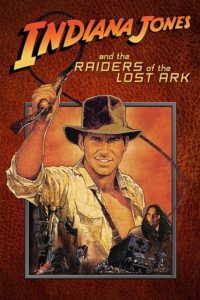
Raiders of the Lost Ark
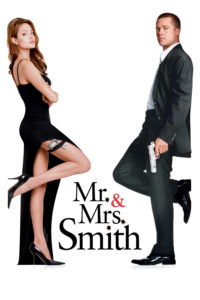
Mr. and Mrs. Smith

Poor Things
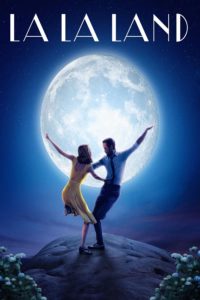
Oppenheimer
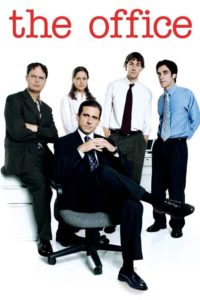
Next Related Article
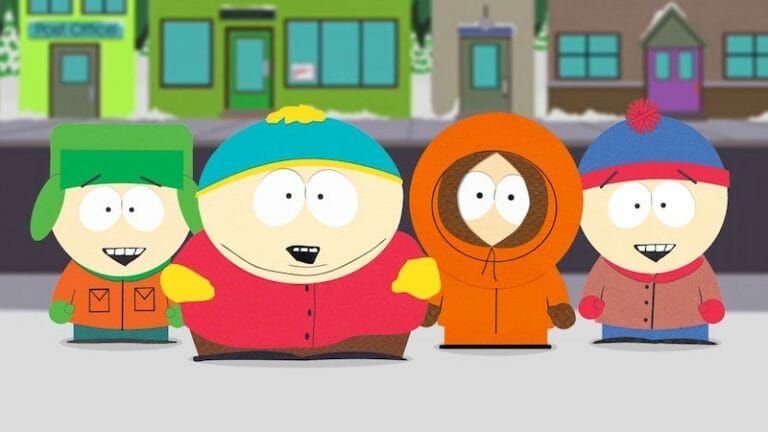
How SOUTH PARK Creators Plot Better Scripts
Ken Miyamoto · June 12, 2020
Recent Articles
A brief history of film noir.
Martin Keady · April 17, 2024
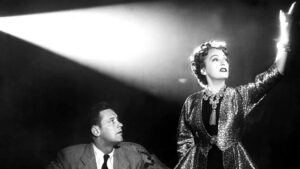
Moving Monologue: The Best Movie Monologues That Leave Audiences Speechless
Ken Miyamoto from ScreenCraft · April 15, 2024
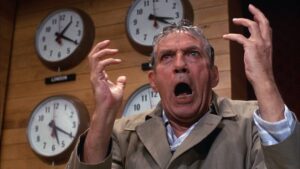
What Is the Wilhelm Scream?
Ken Miyamoto from ScreenCraft · April 10, 2024
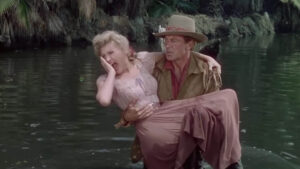
The Script Development Fund
Deadline: April 19th, 2024

Launch Pad Prose Competition
Deadline: April 20th, 2024

Deadline: May 20th, 2024
More Related Articles
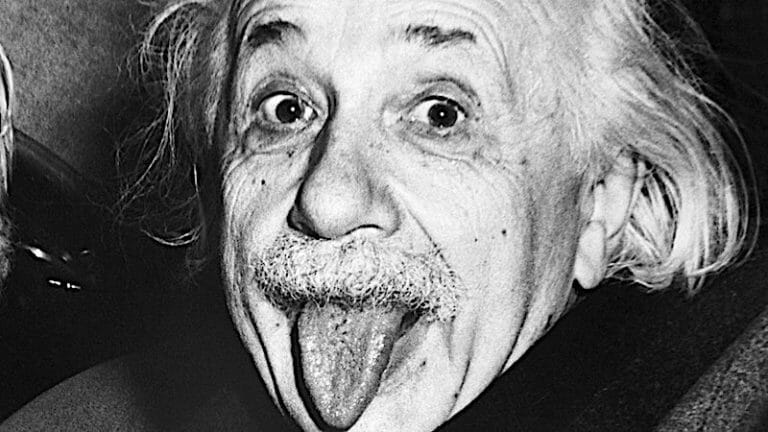
“The Einstein Technique” of Creative Thinking for Writers
Ken Miyamoto · June 26, 2020
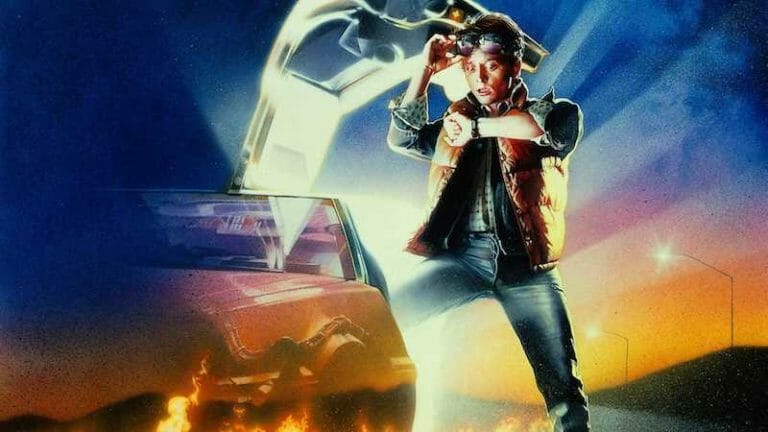
The Hero’s Journey Breakdown: Back to the Future
Ken Miyamoto · June 21, 2020

How to Format TV Sitcom Scripts
Andrew Schwartz · June 10, 2020
© 2024 The Script Lab - An Industry Arts Company
Sign up for the TSL Newsletter
and get $50 off Final Draft 12
Stay up to date on the latest scripts & screenwriting articles.
- Newsletters
- Account Activating this button will toggle the display of additional content Account Sign out
Pages from the Official Star Trek Writers’ Guide, 1967
The Vault is Slate ’s new history blog. Like us on Facebook ; follow us on Twitter @slatevault ; find us on Tumblr. Find out more about what this space is all about here .
These excerpts from a 31-page photocopied writers’ guide for the original Star Trek series show how early Trek episodes were crafted. The guide, written in 1967, was meant to help writers for the year-old show—as well as prospective writers working on spec scripts—nail the tone and content of a typical “Trek” episode.
The pages list characters and their attributes (Captain Kirk is “a space-age Horatio Hornblower, constantly on trial with himself, a strong, complex personality”), outline dos and don’ts of costuming (no pockets; no space suits), and suggest places where writers working outside the studio can seek technical advice (ask nearby universities, “your local NASA office,” or anyone in the “aero-space research and development industry”).
Coming at the tail end of a decade and a half of science fiction television of variable quality , “Star Trek” was eager to establish itself as a new breed of more realistic space opera. The third page image below describes a scenario in which Captain Kirk comforts a female crewmember as an alien vessel attacks. The guide asks readers to identify the problem with this “teaser.” The answer: “Concept weak. This whole story opening reeks too much of ‘space pirate’ or similar bad science fiction.” Captain Kirk would never hug a fellow crewman as danger approached; he’d be too busy trying to solve the problem.
It’s clear that the guide’s anonymous author knew that those in charge were asking a lot of their writers. At the end of a list of Frequently Asked Questions appears this one:
Q: Are you people on LSD?
A: We tried, but we couldn’t keep it lit.
The entire guide isn’t online; you’ll have to make a pilgrimage to Harvard’s Houghton Library to see it. Thanks to the Houghton Library’s Leslie Morris. Read more in Slate about Star Trek.
The Star Trek Guide. 1967. Call number f AC95.A100.967s . Purchased with the Roger Eliot Stoddard Book Fund, 2011. Collection of Houghton Library , Harvard University.
The Star Trek Guide. 1967. Call number f AC95.A100.967s. Purchased with the Roger Eliot Stoddard Book Fund, 2011. Collection of Houghton Library , Harvard University.
The Star Trek Guide. 1967. Call number f AC95.A100.967s . Purchased with the Roger Eliot Stoddard Book Fund, 2011. Collection of Houghton Library , Harvard University.
- Cast & crew
- User reviews

In the 23rd Century, Captain James T. Kirk and the crew of the U.S.S. Enterprise explore the galaxy and defend the United Federation of Planets. In the 23rd Century, Captain James T. Kirk and the crew of the U.S.S. Enterprise explore the galaxy and defend the United Federation of Planets. In the 23rd Century, Captain James T. Kirk and the crew of the U.S.S. Enterprise explore the galaxy and defend the United Federation of Planets.
- Gene Roddenberry
- William Shatner
- Leonard Nimoy
- DeForest Kelley
- 277 User reviews
- 99 Critic reviews
- 16 wins & 31 nominations total
Episodes 80

Photos 1991

- Captain James Tiberius 'Jim' Kirk …

- Mister Spock …

- Lieutenant Leslie …

- Nurse Chapel …

- Ensign Freeman …

- Yeoman Rand …

- Announcer …
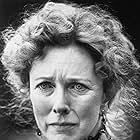
- Beta 5 Computer …
- Security Guard …
- All cast & crew
- Production, box office & more at IMDbPro
Stellar Photos From the "Star Trek" TV Universe

More like this

Did you know
- Trivia In the hallways of the Enterprise there are tubes marked "GNDN." These initials stand for "goes nowhere does nothing."
- Goofs The deck locations for Kirk's Quarters, Sickbay and Transporter Room vary (usually between decks 4-7) throughout the series.
Dr. McCoy : "He's dead, Jim."
- Crazy credits On some episodes, the closing credits show a still that is actually from the Star Trek blooper reel. It is a close-up of stunt man Bill Blackburn who played an android in Return to Tomorrow (1968) , removing his latex make up. In the reel, He is shown taking it off, while an off-screen voice says "You wanted show business, you got it!"
- Alternate versions In 2006, CBS went back to the archives and created HD prints of every episode of the show. In addition to the new video transfer, they re-did all of the model shots and some matte paintings using CGI effects, and re-recorded the original theme song to clean it up. These "Enhanced" versions of the episodes aired on syndication and have been released on DVD and Blu-Ray.
- Connections Edited into Ben 10: Secrets (2006)
- Soundtracks Star Trek Music by Alexander Courage
User reviews 277
- May 6, 2003
Lovable Creatures: Our Favorite Screen Pals

- How do they maintain Gravity on the the U.S.S. Enterprise ? .
- All aliens on all planets speak the English language?
- What does "TOS" mean?
- September 8, 1966 (United States)
- United States
- Star Trek: The Original Series
- Backlot, Culver Studios - 9336 W. Washington Blvd., Culver City, California, USA
- Desilu Productions
- Norway Corporation
- Paramount Television
- See more company credits at IMDbPro
Technical specs
- Runtime 50 minutes
Related news
Contribute to this page.
- IMDb Answers: Help fill gaps in our data
- Learn more about contributing
More to explore

Recently viewed
ARCHIVEGRID
Star trek: the original series scripts and writer's guides, 1965-1968, ohio state university, related resources, more like this.
- Newsletters
Site search
- Israel-Hamas war
- 2024 election
- Solar eclipse
- Supreme Court
- All explainers
- Future Perfect
Filed under:
Harlan Ellison wrote Star Trek’s greatest episode. He hated it.
The famously cantankerous science-fiction legend died this week. The story of “City on the Edge of Forever” represents his career in miniature.
Share this story
- Share this on Facebook
- Share this on Twitter
- Share this on Reddit
- Share All sharing options

Share All sharing options for: Harlan Ellison wrote Star Trek’s greatest episode. He hated it.
/cdn.vox-cdn.com/uploads/chorus_image/image/60225323/GettyImages_514787175.0.jpg)
Harlan Ellison, the legendary, legendarily irascible speculative fiction writer who died this week at age 84 , wrote the greatest episode of Star Trek ever made. And he hated it.
“The City on the Edge of Forever” aired on April 6, 1967, late in the original series’ first season , and won acclaim for capturing everything Star Trek could do at its best while suggesting weighty themes and emotional depths only hinted at in previous episodes. It won the Hugo Award for Best Dramatic Presentation and the Writers Guild of America Award for Best Episodic Drama on Television. Ellison accepted both. Neither salved his bitterness that the episode had been rewritten.
At the Hugos he dedicated the award to “the memory of the script they butchered, and in respect to those parts of it that had the vitality to shine through the evisceration.” “The City on the Edge of Forever” that aired may have been praised by virtually everyone who saw it, but it wasn’t his “City on the Edge of Forever,” and a compromised triumph was no triumph at all for Ellison. Ellison would spend the next several decades being publicly aggrieved by “City on the Edge of Forever.”
Was the reaction overkill? Of course. Overkill was part of Ellison’s persona. He held grudges. He deployed lawsuits liberally, sometimes successfully. (He’s now acknowledged in the credits of The Terminator thanks to one such suit.) He boasted of assaulting his publisher in the ’80s . And many never looked at him the same way after he groped author Connie Willis at the Hugos in 2006, for which he apologized — then grew angry when the apology wasn’t immediately accepted.
Ellison was famous for his contributions to science fiction and American literature, which extend well beyond his Star Trek script. But he was also famous for his grievances. The story of “The City on the Edge of Forever” represents that duality in miniature, and helps explain what made him both a beloved and divisive figure.
Star Trek ’s best episode is credited to Harlan Ellison alone. It was a lie he would not let stand.
:no_upscale()/cdn.vox-cdn.com/uploads/chorus_asset/file/11620843/GettyImages_493210521.jpg)
Here’s the version of “The City on the Edge of Forever” that’s been seen by countless viewers since 1967: After administering a small dose of a dangerous drug to Lt. Sulu (George Takei), Dr. McCoy (DeForest Kelley) accidentally administers a massive dose to his own abdomen after getting knocked about when the Enterprise hits some interference from a strange time distortion.
Driven temporarily mad, McCoy beams down to the nearest planet, home to the Guardian of Forever, a talking portal that allows visitors to travel through time and space. When McCoy uses it to travel back to Depression-era New York, the Enterprise ’s landing party learns their ship has disappeared. Whatever McCoy has done has distorted history in such a way that the universe as they know it has ceased to exist.
Captain Kirk (William Shatner) and Mr. Spock (Leonard Nimoy) give chase, in time learning that McCoy has changed time by saving the life of Edith Keeler (Joan Collins), the near-saintly proprietor of a soup kitchen. If allowed to live, her idealistic message of pacifism and tolerance will delay the United States’ entry into World War II, allowing Hitler to develop the atomic bomb, win the war, and dominate the Earth — shutting the door on the hopeful future imagined throughout the series.
And so, as Spock says twice in the episode — first as a question then as a statement arrived at through cold, hard logic — Edith Keeler must die. The only problem: Kirk has fallen in love with her and isn’t sure he can bring himself to let her die. But, after reuniting with McCoy, he does just that, stopping the doctor from saving Edith from a truck that strikes her down in the street.
Many elements contribute to the episode’s greatness. The Guardian’s planet is an eerie, dreamlike place, one that inspires Kirk to comment, with understated poetic flair, “These ruins stretch to the horizon.” Journeyman director Joseph Pevney wisely lets the atmosphere, both of the alien world and 1930s New York, do a lot of the work.
Then there’s Shatner, who, often justifiably, gets a lot of flak for laying it on thick, but his performance here is measured. His love for Edith feels real, far removed from the flings seen in previous episodes. So does his heartbreak.
Yet much of the brilliance can be traced back to the script. Star Trek had raised philosophical issues before, but few as thorny as whether taking one life can be justified in the name of a greater good. And not just any life: Kirk falls for Edith because she’s virtuous and beautiful and finds him charming, sure, but also because she’s the living embodiment of the utopian principles he’s sworn to uphold as a member of Starfleet.
She believes in humanity’s potential to overcome hatred and selfishness, in the possibility of the better future in which Kirk lives. But to make that future possible, he has to let her die. She has the right message at the wrong time. It’s a Kobayashi Maru scenario in the form of a tragic romance.
It’s a near-perfect episode of television, recognized as such from the moment it aired. The credits bore only one name: Harlan Ellison.
Ellison knew it was a lie. He’d seen the script through several drafts, only to have it reworked, at Star Trek creator Gene Roddenberry’s insistence, by D.C. Fontana, Gene Coon, Steven W. Carabatsos, and Roddenberry himself. Ellison asked his name be taken off, but backed down. It would be the last time he backed down on this matter.
Most writers would sit back, take the praise, and keep quiet about the sausage-making process. Ellison wasn’t most writers, telling anyone who’d listen what had happened to his script, all the alterations and adjustments that made it lesser than the version he’d dreamed up. In 1975, during a short-lived rapprochement with Roddenberry, Ellison published the original version in his collection Six Science Fiction Plays , allowing the curious to compare and contrast the version they knew with the version that might have been.
Ellison’s version shares much of the filmed version’s bone structure. The time travel, Edith Keeler, the central moral question are all there. But it also contains a murderous drug-dealing crew member (an element Roddenberry found out of sync with his vision of an idealized future and a squeaky clean Starfleet), alternate-universe space pirates summoned into existence by the altering of time, 9-foot aliens (who would become the much more budget-friendly talking portal), and a World War I veteran named Trooper.
Most significantly, at the climactic moment, Kirk can’t bring himself to let Edith die. It’s Spock who makes the choice. Ellison saw Kirk as a man who, at a critical juncture, couldn’t let the love of his life die to save the universe. Roddenberry thought otherwise. The question of which feels truer to Kirk, and to Trek , serves as a litmus test for fans of the show.
Without Ellison’s talent and imagination, “The City on the Edge of Forever” wouldn’t have existed. Applying the butterfly effect to its absence — appropriate, given the episode’s plot — the Star Trek we know today wouldn’t have been possible without the ripples of complexity and moral ambiguity Ellison helped introduce to the series. (Not that Ellison had anything nice to say about the later series.)
But Ellison, whose early history includes multiple stories of running away from home, could seemingly never live comfortably in any world, even a world he helped create, be it Star Trek or the larger world of speculative fiction, which he helped shape with his work and his championing of other writers. Because Ellison could always imagine a better world, one in which “The City on the Edge of Forever” aired without evisceration, one in which the same sort of piggish shortsightedness that led to that evisceration wasn’t allowed to run rampant in so many aspects of life, one in which everyone finally saw he was right.
Reflecting on “The City on the Edge of Forever” years later, Ellison wrote, “The solitary creator, dreaming his or her dream, unaided, seems to me to be the only artist we can trust.” Ellison did a lot of that sort of dreaming. Sometimes the dreams went astray.
Ellison always had to have the last word. And then he’d just keep talking.
Ellison’s adventures in the TV trade — there would be more, and more frustrations — prompted him to write about television for the Los Angeles Free Press, unsparing observations collected in the influential 1970 book The Glass Teat and its sequel, The Other Glass Teat . It also assured he’d keep prose as his primary profession, helping to shepherd and elevate the literary careers of others.
The landmark collection Dangerous Visions , a collection of stories from science fiction stars and stars-to-be, appeared the same year as “The City on the Edge of Forever.” Again, Dangerous Visions followed in 1972. (A long-promised third volume never arrived.) He mentored Octavia Butler and others. He wrote. And wrote. And wrote. In a 2013 interview with the Guardian , Ellison put his tally at around 1,800 short stories, novellas, essays, and scripts. Today, “The City on the Edge of Forever,” both the filmed teleplay and Ellison’s original drafts, represent only a tiny fraction of his output and influence.
:no_upscale()/cdn.vox-cdn.com/uploads/chorus_asset/file/11620869/GettyImages_453124640.jpg)
But even with his version of “The City on the Edge of Forever” available for the world to read, the matter felt unsettled for Ellison. It didn’t help that Roddenberry was out there telling his version of the story, claiming that Ellison’s script was filled with budget-breaking elements and that he had Commander Scotty dealing drugs.
Ellison knew better. The pirates were added at Roddenberry’s insistence and Scotty never dealt drugs in any drafts. He didn’t even appear in any drafts. Then there was all that money others were making from the episode, money that seemed never to find its way to Ellison.
This would not stand. So in 1995, four years after Roddenberry’s death, Ellison published “The City on the Edge of Forever” again, this time as a standalone book titled The City on the Edge of Forever: The Original Teleplay . The book includes two treatments for the episode; Ellison’s final draft of the screenplay; testimonials from Fontana, Kelley, Nimoy, and others; and a new introduction from Ellison designed to set the record straight.
The opening sets the tone:
“Speak no ill of the dead? Oh, really? Then let’s forget about a true introductory essay to this book. Let’s give a pass to setting the record straight. Let’s just shrug and say, ah, what the hell, it’s been more than thirty years and the bullshit has been slathered on with a trowel for so damned long, and so many greedy little pig-snouts have made so much money off those lies, and so many inimical forces continue to dip their pig-snouts in that Star Trek trough of bullshit that no one wants to hear your miserable bleats of “unfair! unfair” … that it ain’t worth the price of admission, Ellison.”
And so it goes for 90 profane, repetitive, discursive, hilarious, pitiless, insightful pages. It’s, in its own way, classic Ellison, who turned interviews into monologues. Smart interviewers generally knew to get out of his way and just let him talk. In the end, Ellison always had the last word. And then he just kept talking.
Ellison was sometimes too much, and too much in ways that are hard to excuse; offenses committed out of an excess of passion are still offenses. But, oh, that passion. Ellison simply had to fight back against every perceived slight and loss. He even had to fight back against any wins that weren’t on his own terms. He left behind miles of scorched earth and a towering body of work. He reshaped science fiction and changed the way his readers looked at the world. It wasn’t enough. Nothing ever was.
Will you support Vox today?
We believe that everyone deserves to understand the world that they live in. That kind of knowledge helps create better citizens, neighbors, friends, parents, and stewards of this planet. Producing deeply researched, explanatory journalism takes resources. You can support this mission by making a financial gift to Vox today. Will you join us?
We accept credit card, Apple Pay, and Google Pay. You can also contribute via
Next Up In Culture
Sign up for the newsletter today, explained.
Understand the world with a daily explainer plus the most compelling stories of the day.
Thanks for signing up!
Check your inbox for a welcome email.
Oops. Something went wrong. Please enter a valid email and try again.

Your brain’s privacy is at risk. The US just took its first big step toward protecting it.
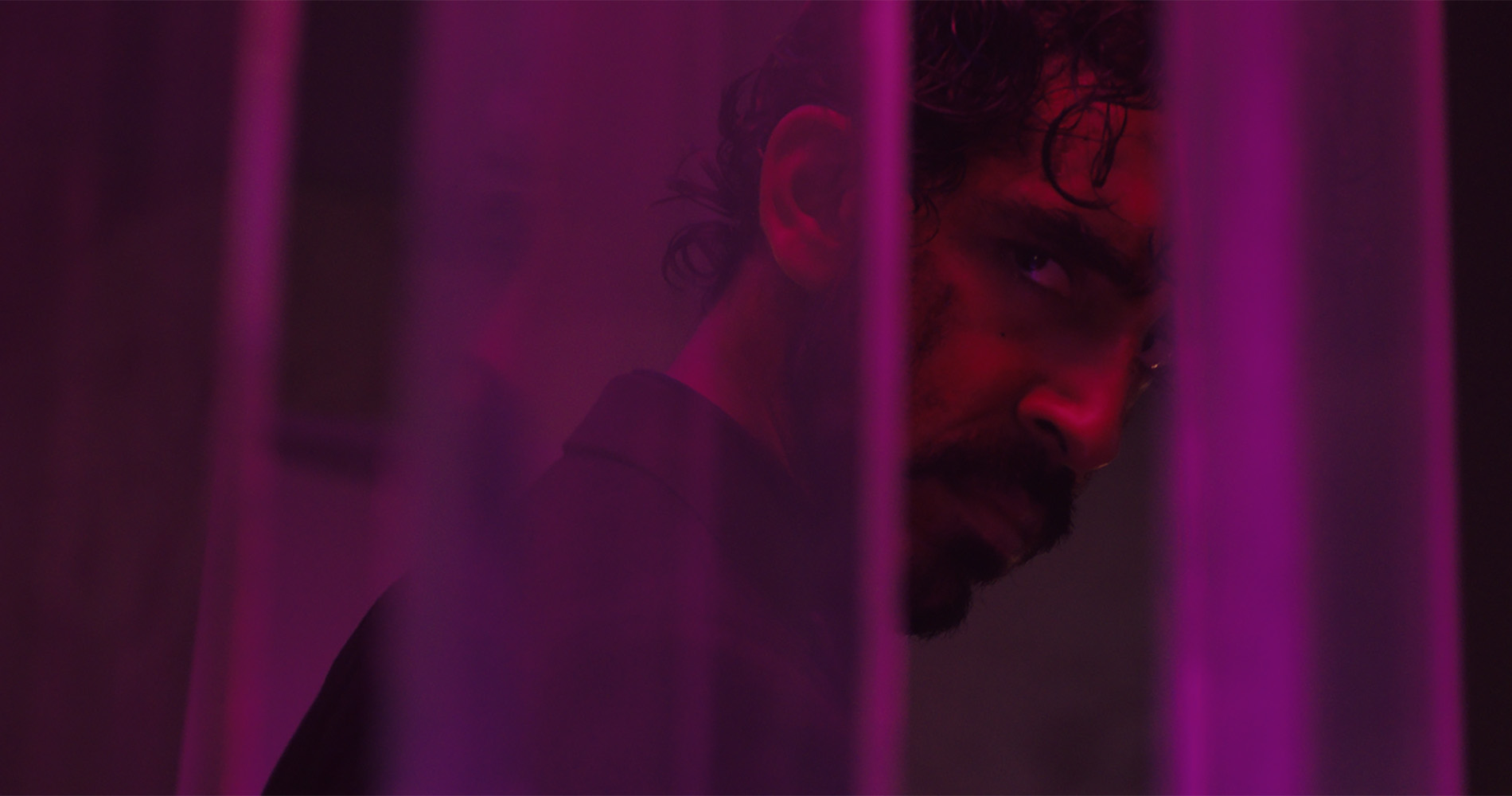
Monkey Man’s imperfect political critique still packs a punch
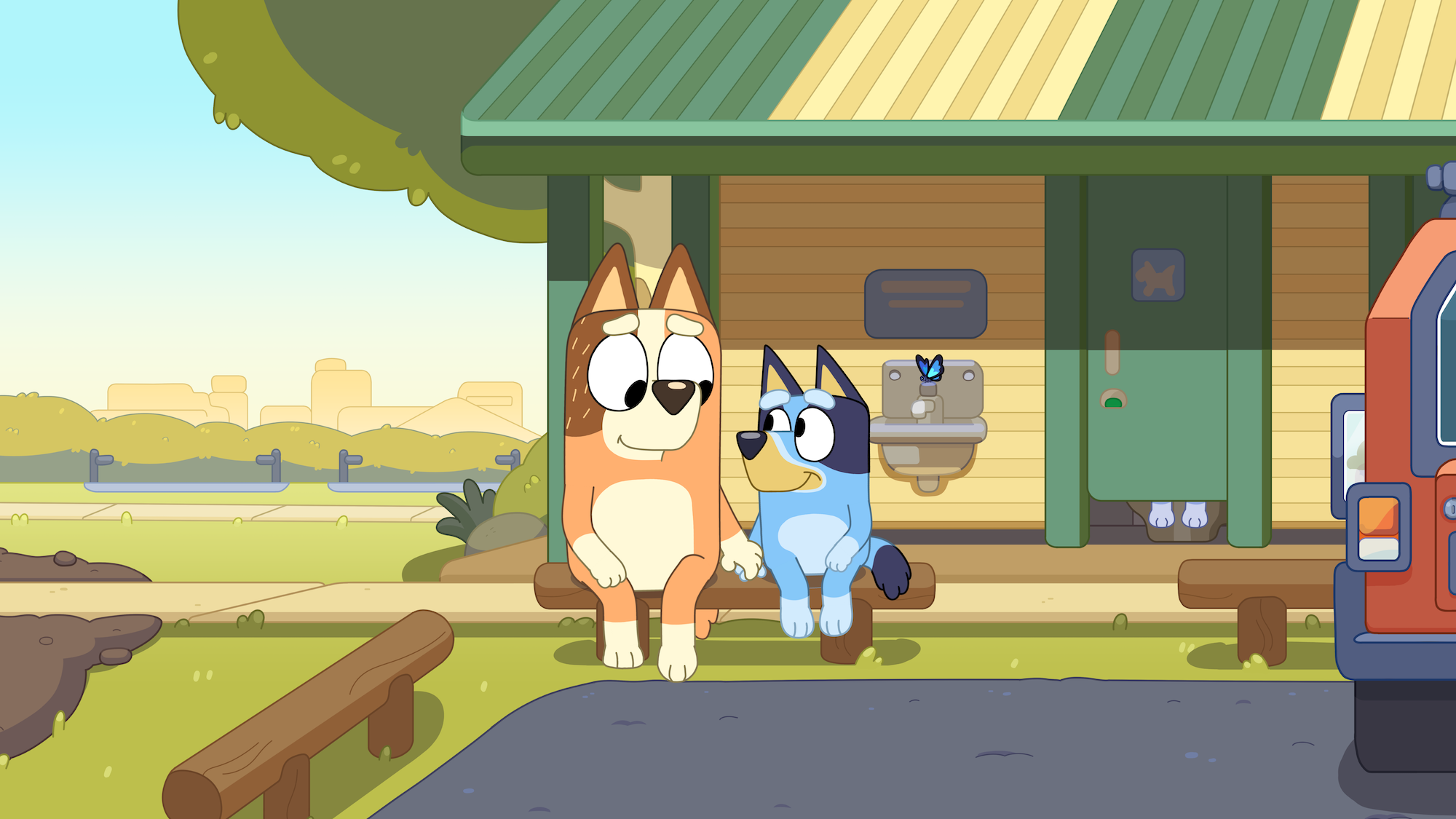
Everything ends. Even Bluey.

The very short Mayorkas impeachment trial, explained

Boeing’s problems were as bad as you thought

Is Israel a “settler-colonial” state? The debate, explained.
List of Star Trek: The Next Generation Writers
List of every famous television writer who has written for Star Trek: The Next Generation, listed alphabetically with photos when available. List includes anyone who was or is on the writing staff for Star Trek: The Next Generation . Staff writers as well as guest writers for Star Trek: The Next Generation are included when available, along with more information about each Star Trek: The Next Generation writer. If you're an aspiring writer and a fan of Star Trek: The Next Generation, then this writing staff from Star Trek: The Next Generation should be studied closely.
This list contains writers like James Caan and Gene Roddenberry.
This list helps answer the question, “Who wrote for Star Trek: The Next Generation?”
Adam Belanoff
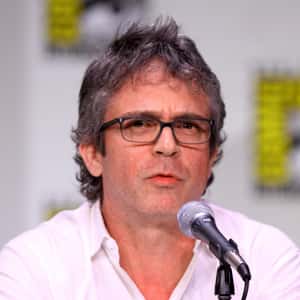
Brannon Braga
Burton armus, d. c. fontana, david bennett carren, david bischoff, david kemper, deborah dean davis.
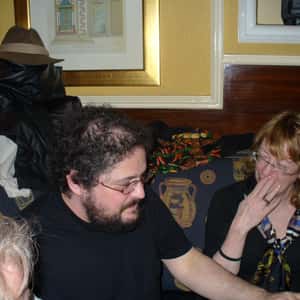
Diane Duane
Edithe swensen.

Eric A. Stillwell
Frank abatemarco, fred bronson.

Gene Roddenberry
- # 133 of 213 on The Greatest Male Celebrity Role Models
- # 34 of 68 on Famous Rosicrucians List
- # 10 of 66 on Who Is The Most Famous Gene In The World?
Grant Rosenberg
Gregory w. amos, hannah louise shearer.
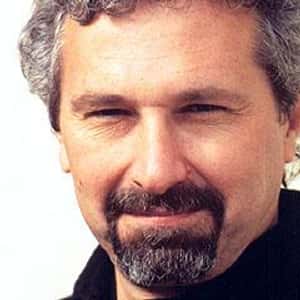
Hans Beimler
Herbert wright, hilary bader, ira steven behr, j. larry carroll, jack b. sowards, jacqueline zambrano.
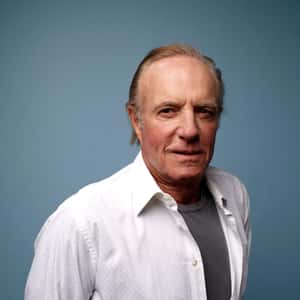
- Dig Deeper... Remembering James Caan: Celebrities, Friends, & People Who Worked With Him Pay Tribute To The Actor
- And Deeper... Actors You May Not Have Realized Are Republican
- # 164 of 227 on The Most Trustworthy Celebrities In The World
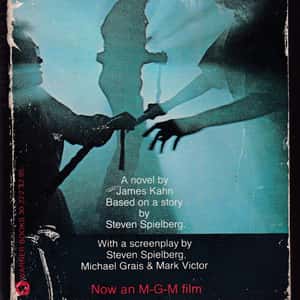
Jeri Taylor
Joe menosky.
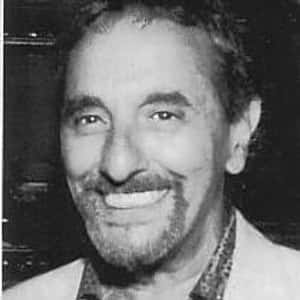
Joseph Stefano
- Star Trek: The Next Generation
- Star Trek Franchise
- Star Trek Universe
- Adventure Entertainment

Star Trek: The Original Series - Open-Ended Episodes That Modern Trek Should Continue
Many Original Series episodes left lingering questions or dangling plot threads that modern Star Trek viewers would love to see picked up.
Star Trek is one of the media world's oldest and most successful franchises, and its first iteration was made in a time when television shows followed a different template. The trend of television now often includes serialized plotlines that take up a whole season, which used to be known as a miniseries. Star Trek: The Original Series consisted mostly of one-and-done episodes that often had open endings. The show was canceled after only three seasons, so writers didn't often have the opportunity to continue an unfinished story.
The most famous example is a dropped story thread from the episode "Space Seed" that was picked up and woven into one of the most successful movies in cinema history: Star Trek: Wrath of Khan . Considering its success, it's a wonder that the makers of Star Trek don't use this technique more often. There are lots of great ideas from the classic show that modern Trek can use, either as a plot in one of the many modern shows or even as a movie premise.
6 The Fate Of Triskelion
"The Gamesters of Triskelion" is one of the more memed episodes of the older show, and it's hard to resist the unique costumes and over-the-top drama. It's one of the more recognizable old episodes, and it also has an open ending that could have some interesting future results.
RELATED: The Most Dangerous Planets In The Star Trek Universe
When Kirk and the crew of the Enterprise leave the planet Triskelion, the slaves that had previously fought for the amusement of the gambling gamesters are now free to build their own civilization. A few hundred years later, it would be an adventure to return and see how the project turned out .
5 Charlie X
The general idea of the precocious, godlike child is a trope of its own, but instead of magical or mysterious occult powers, Charlie X was raised by non-corporeal alien beings and has powers that no human should possess. He uses them to try and take over the Enterprise, and comes very close to succeeding before he is spirited away by his formless guardians.
RELATED: Best Star Trek Admirals, Ranked
It was clear that Charlie didn't want to leave the ship, the first place where he had been able to interact with other human beings, and the ending is a tragic one. The question of what eventually became of Charlie, as well as the identity of the beings that took him in when he was abandoned in a crash, is never resolved.
4 The Plight Of Planet Scalos
The episode "Wink Of An Eye" was based on a creative premise that played with speed, time, and alternate forms of existence. The older trope that formed the basis for the story was that of the dying race on a crumbling planet , looking for recruits to compensate for their falling fertility rates.
The Scalosians attempt to seize the Enterprise and the whole crew for their purposes, and naturally, the heroes thwart them. The Enterprise departs in peace, but what became of the Scalosians after that? Kirk and the crew were only there to answer an old distress call, so did the Scalosians ever solve their problem, or did they go extinct?
3 Flint The Inventor
There are more things in heaven or on earth than are dreamed of in Horatio's philosophy, or maybe his name was Flint. This obscure episode appears to be the genesis of a variety of big box office concepts, from The Highlander to Bladerunner. The main character is a human who can't die, and in his eternal boredom, builds a perfect human-like android.
RELATED: Potential Premises For A New Star Trek Movie
The mystery of Flint's immortality was never solved, and in the end, his experiment on Rayna was a failure, but what about the huge body of lost work that he left behind? Spock identified some of it as being priceless, not only in monetary cost but intellectual value. It would be interesting to find out what happened to Flint's historic treasure trove.
2 The World Of Yonada
The title of this episode, "For The World Is Hollow and I Have Touched The Sky," gives away part of the twist. This is not a planet, but a spaceship disguised as one, and the people who inhabit it are none the wiser. The Enterprise crew discovers that this spaceship has malfunctioned, and is on a collision course with an inhabited planet, so they visit Yonanda in an attempt to correct the ship's wayward route.
They succeed, and the last scene of the episode consists of some exposition as to when the ship will reach its final destination, only a little more than a year. It's strongly hinted that McCoy would return since he had a personal reason, but the story was never told.
1 The Shore Leave Planet
Although there are several "pleasure planets" throughout the galaxy , with Risa the most famous example from The Next Generation era, none of them were quite like the planet in "Shore Leave." In addition to the planet's natural beauty, it also had the power to manifest anything the visitors' hearts could desire. This sounds great, but it can also have deadly consequences.
After some hijinks that are exciting and rather shocking but mostly harmless, the crew figures out the planet's secret and they have a restful shore leave. Considering how much potential this had for other stories, it's disappointing that writers never visited the concept again.
MORE: Star Trek: The Next Generation - Things You Didn’t Know About The Show’s Production
- More to Explore
- Series & Movies
Published Apr 10, 2024
A Brief History of the Progenitors in Star Trek
They designed life itself!
SPOILER WARNING: This article contains story details and plot points for Star Trek: Discovery 's "Red Directive ."

StarTrek.com
Captain Burnham's top-secret mission in the final season of Star Trek: Discovery has finally been revealed. But this time, the Discovery crew isn’t stopping a future-destroying A.I., or a lethal, extra-galactic force. Instead, they’re investigating the basic mysteries of why most species in the Star Trek universe look vaguely human.
As revealed in " Red Directive ," the search for technology used by ancient "Progenitors" sets-up a massive treasure hunt for the season. But, who are the Progenitors? What did Jean-Luc Picard know about the secrets of inter-species alien DNA? And how does all of this fit in with Gene Roddenberry’s earliest ideas for Star Trek ?
Here’s a brief history of the Progenitors, from the early 1960s, to the 24th Century, all the way to 2024, and the 31st Century.
The Real World-Origins of the Progenitors

"The Cage"
When the U.S.S. Enterprise first set out to seek out "new life and new civilizations," a huge swath of those alien lifeforms turned out to look a lot like human beings. And the primary reason for that, at least behind-the-scenes, was two-fold.
First, human actors are more affordable, and second, Gene Roddenberry wanted the classic Star Trek to avoid the sci-fi trope of "Bug-Eyed Monsters." And so, in one of the original 1964 pitch documents for Star Trek , Roddenberry floated the idea of "The Parallel Worlds" concept . The idea was that the format of Star Trek — from a writing and production standpoint — would generally deal with "...plant and animal life, plus people, quite similar to Earth. Social evolution will also have interesting points of similarity with ours."
Unlike a huge swath of science fiction on TV at the time, the promise of strange, new worlds, that were, in fact, populated by people , is something that set Star Trek apart, and was the cornerstone of what gave the series its humanist angle. But, the side effect of course, was an in-universe question — why were so many aliens humanoid?
The Old Ones, Sargon, and The Preservers

"The Paradise Syndrome"
The first two seasons of The Original Series are sprinkled with hints that, in the distant past, the galaxy was visited by super-powered aliens with technology far more advanced than anything in the Federation.
In " What Are Little Girls Made Of? ," we meet Ruk, an android built by "The Old Ones," an alien race capable of creating humanoid androids that were basically immortal. In " Return to Tomorrow ," the disembodied soul of Sargon, refers to humanity as "my children." While Dr. Muhuall says this idea flies in the face of evolutionary theory, Spock mentions the idea that aliens seeded life would "explain certain elements of Vulcan pre-history."
Then in Season 3, in " The Paradise Syndrome ," Bones and Spock tackle the question head-on. When they realize an ancient race of "Preservers" helped various humanoid species throughout the galaxy, the idea of an ancient alien race guiding and "seeding" a ton of humanoid species became less of a myth and more of a working theory. "I’ve always wondered why there were so many humanoids scattered through the galaxy," Bones says. To which Spock replies, "So have I. Apparently, the Preservers account for a number of them."
And then, the questions about an ancient humanoid species went answered. At least, until The Next Generation .
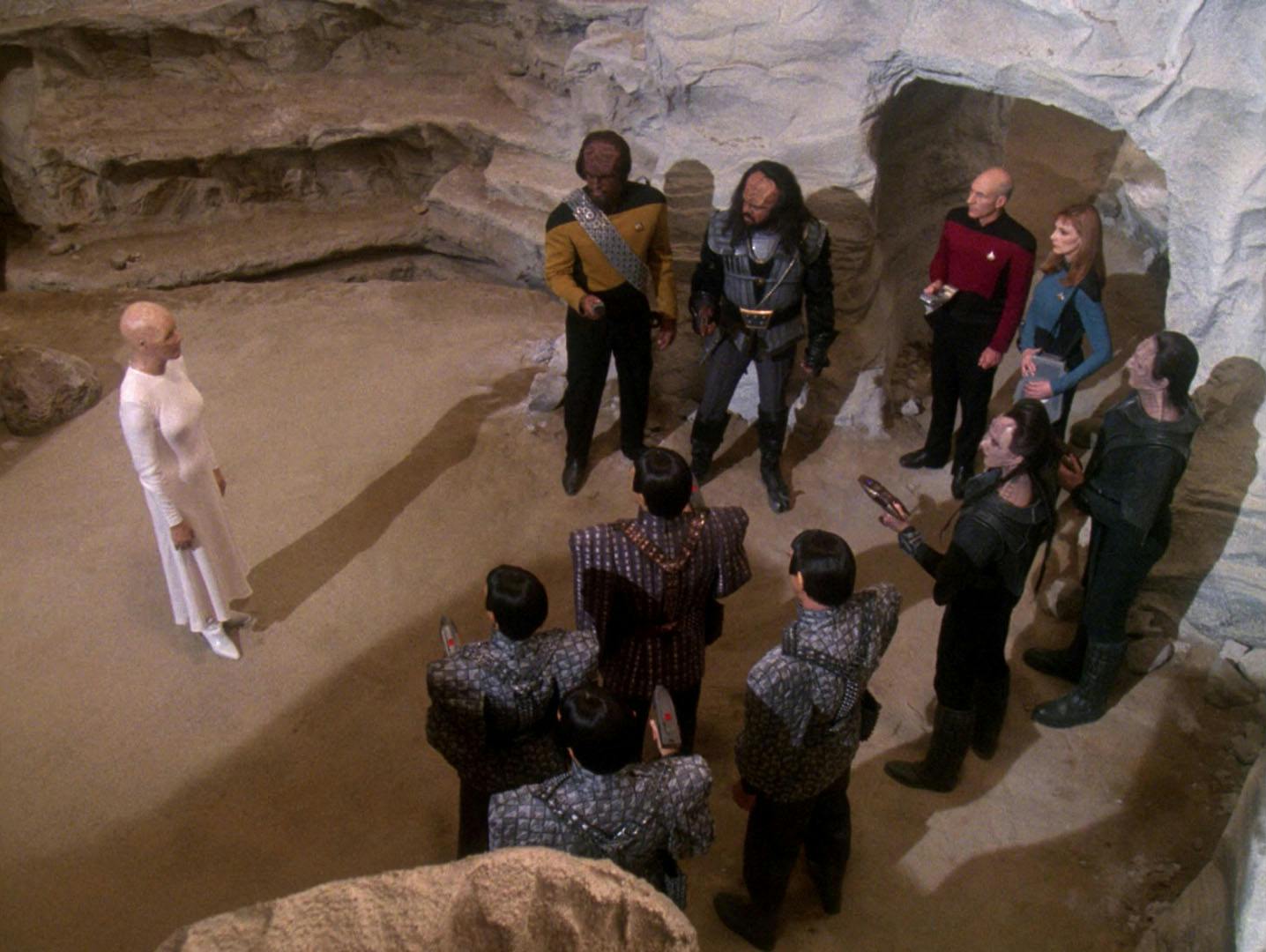
"The Chase"
Directed by Jonathan Frakes and written by Ronald D. Moore and Joe Menosky, " The Chase " was a sixth-season episode of The Next Generation , which, according to The Next Generation Companion , was considered in the writers' room the most "Roddenberryesque" episode of TNG at that time. The story itself took cues from Carl Sagan's novel Contact , and posited that yes, ancient aliens not only seeded most of the humanoid species, but also hid a message in the DNA of all those species.
Captain Picard's interest in archeology comes in handy during the quest to locate all the DNA strands and reveal the message, which was also represented metaphorically by the ancient artifact known as the Kurlan naiskos .
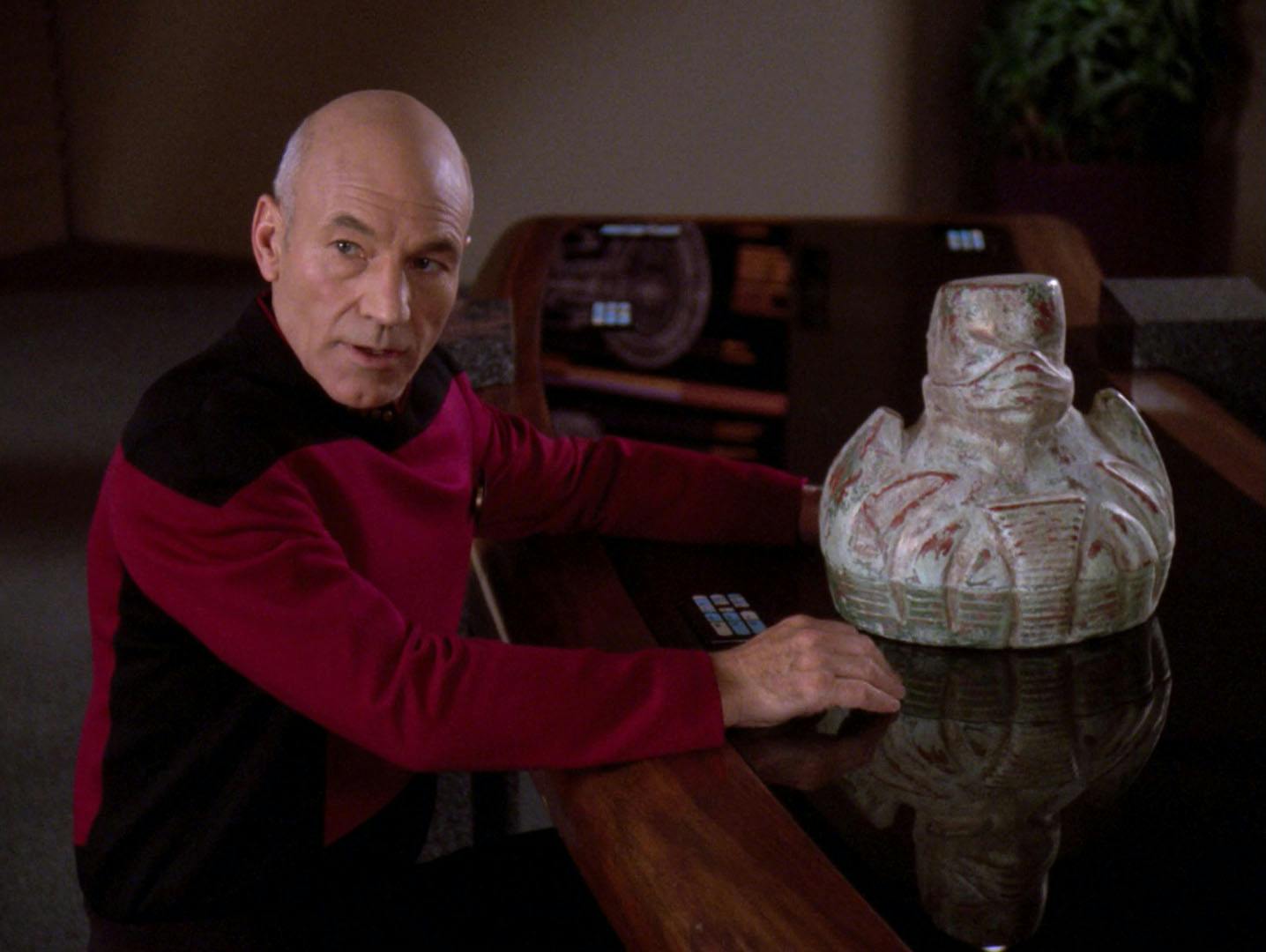
At the end of the episode, representatives from the Klingon Empire, the Romulan Empire, the Cardassian Union, and the Federation, all witness the truth — an ancient Progenitor (played by Salome Jens) makes it clear that all the humanoid species in the galaxy don’t exist out of pure hubris, but instead, out of a kind of desire for legacy. "You are a monument, not to our greatness, but to our existence…. Remember us."
Ronald D. Moore pointed out that there's no reason to believe that the Progenitors from "The Chase" and the Preservers from TOS aren't one in the same. Though not explicitly stated in the script, he said, "But this could be them, and be internally consistent."
Discovery Brings It All Home
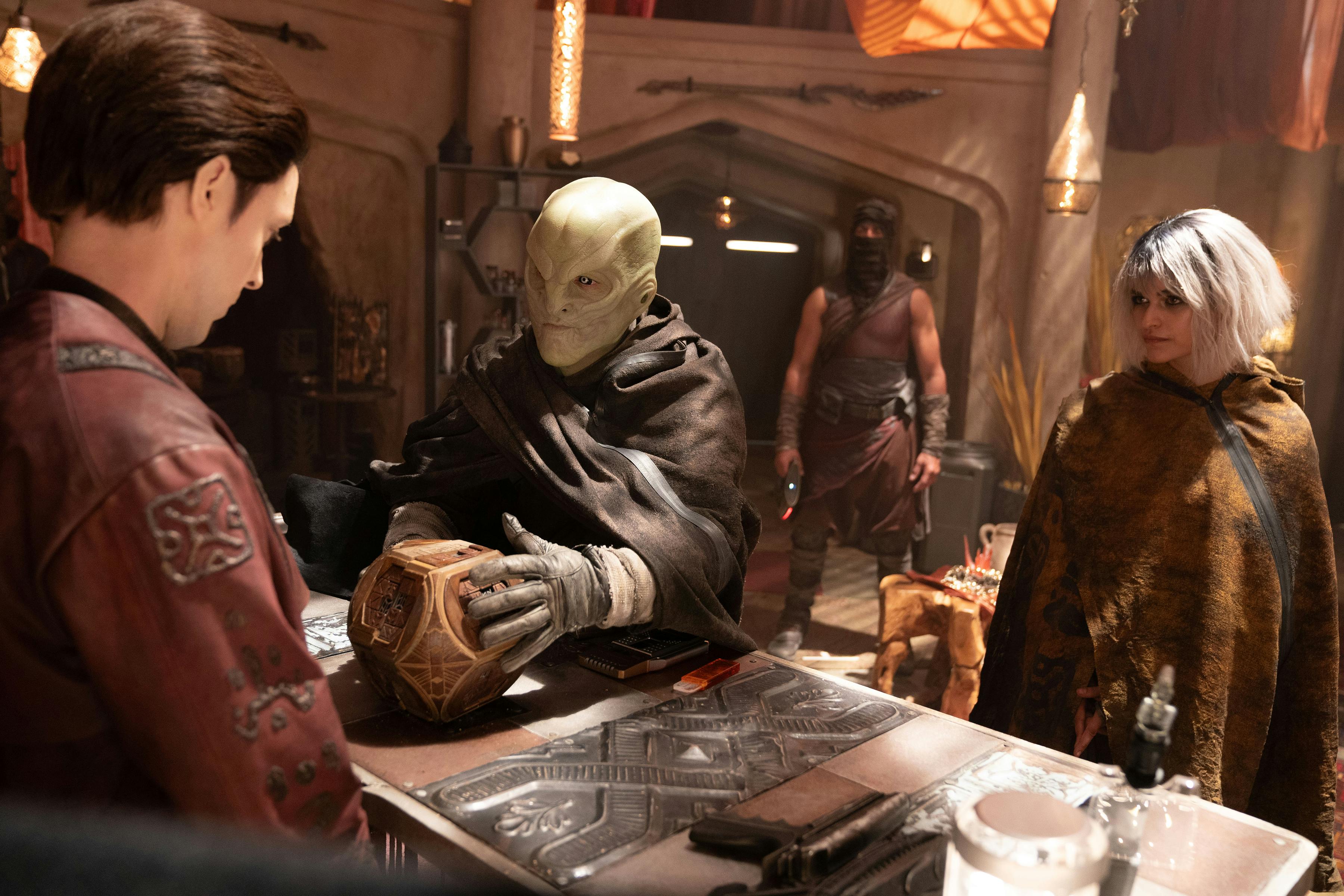
"Red Directive"
While The Next Generation established a canonical fact that TOS only danced around, that only answered the question of why . With Discovery Season 5, a stranger, and more complex question is getting broached — how ?
"The Chase" told us why there are so many humanoid species in the galaxy, but we had no idea how the Progenitors specifically pushed life to evolve on various planets toward the exact form of life we’re all so familiar with. As the crew of Discovery — and other forces — are in pursuit of this ancient tech, Star Trek is boldly speculating on one of the biggest questions of all time.
If there was a supreme intelligence behind the creation of life, what was their method? While these kinds of questions are somewhat mind-boggling in real life, what Discovery is doing now is what Star Trek has done all along: Ask provocative questions that are beyond what we know now, so that maybe, in the future, we’ll be better prepared.
We don’t know that the Progenitors exist in real science, but the "panspermia hypothesis," is a very real scientific concept. A friendly alien may not have consciously sparked life on Earth eons ago, but, in reality, it is possible that some building blocks for life itself may have come from the stars.
Get Updates By Email
Ryan Britt is the author of the nonfiction books Phasers on Stun! How the Making and Remaking of Star Trek Changed the World (2022), The Spice Must Flow: The Journey of Dune from Cult Novels to Visionary Sci-Fi Movies (2023), and the essay collection Luke Skywalker Can’t Read (2015). He is a longtime contributor to Star Trek.com and his writing regularly appears with Inverse, Den of Geek!, Esquire and elsewhere. He lives in Portland, Maine with his family.
Star Trek: Discovery Seasons 1-4 are streaming exclusively on Paramount+ in the U.S., the UK, Canada, Switzerland, South Korea, Latin America, Germany, France, Italy, Australia and Austria. Seasons 2 and 3 also are available on the Pluto TV “Star Trek” channel in Switzerland, Germany and Austria. The series streams on Super Drama in Japan, TVNZ in New Zealand, and SkyShowtime in Spain, Portugal, Poland, The Nordics, The Netherlands, and Central and Eastern Europe and also airs on Cosmote TV in Greece. The series is distributed by Paramount Global Content Distribution.
- Star Trek 101

Long-lost first USS Enterprise model returned to 'Star Trek' creator Gene Roddenberry's son

Remove the ads from your TribLIVE reading experience but still support the journalists who create the content with TribLIVE Ad-Free.
Get Ad-Free >
TribLIVE's Daily and Weekly email newsletters deliver the news you want and information you need, right to your inbox.
News Spotlight
- How to Pick the Dodgers vs. Padres Game with Odds, Betting Line and Stats - April 14 TribLive
- The Essential Guide to Selecting a Qualified Tree Service Provider: 5 Must-Have Credentials BeaverJack Tree Service, LLC Partner News
- The Process of Bread Making From Scratch? The Breadery Partner News
- Asian Americans and Pacific Islanders in U.S. more likely to believe in climate change: AP-NORC poll TribLive
- How to Watch Tigers vs. Twins on TV or Streaming Live - Sunday, April 14 TribLive
- Mayor of North Carolina's capital city won't seek reelection this fall AP
- From White to Black Belt: A Child's Journey to Building Confidence and Discipline Through Karate Norwin Ninjas Partner News
- Penn Hills real estate transactions for the week of May 24 NNNPennHills
- Watching the Solar Eclipse at Foggy Mountain Lodge: What You Need to Know Foggy Mountain Lodge Partner News
- How to Build Confidence in Kids Through Martial Arts Training Norwin Ninjas Partner News
TV Talk: Locally made thriller ‘Godless Children’ to stream; ‘The Jinx’ re-animates Durst’s trial

- View history
Jerry Sohl ( 2 December 1913 – 4 November 2002 ; age 88) was a science fiction prose writer, who wrote three episodes of Star Trek: The Original Series . For television, he first ghost-wrote episodes of The Twilight Zone for Charles Beaumont , who was suffering from Alzheimers. He used the pseudonym of Nathan Butler for his credit on " This Side of Paradise " because he was displeased with D.C. Fontana 's rewrite of his original script.
Star Trek credits [ ]
- " The Corbomite Maneuver "
- " This Side of Paradise " (story; credited as Nathan Butler )
- " Whom Gods Destroy " (story)
External links [ ]
- Jerry Sohl at the Internet Movie Database
- Jerry Sohl at SF-Encyclopedia.com
- Jerry Sohl at Wikipedia
Screen Rant
Star trek: discovery explains season 5’s tribble is not a threat.
A Tribble was sighted aboard the USS Discovery, which should be alarming, but Star Trek: Discovery season 5 explains this Tribble is no trouble.
Warning: SPOILERS for Star Trek: Discovery Season 5, Episode 3 - "Jinaal"
- Tribbles are no trouble on the USS Discovery in Star Trek: Discovery season 5.
- Discovery's Tribble was neutered so there is no threat of it breeding and taking over the ship.
- Tribbles can be safely kept as pets in Star Trek: Discovery season 5 after genetic alterations.
The sight of a Tribble aboard the USS Discovery should be alarming, but Star Trek: Discovery season 5 explained this Tribble is no trouble at all. Written by Kyle Jarrow and Lauren Wilkinson and directed by Andi Armaganian, Star Trek: Discovery season 5, episode 3, "Jinaal" brings the USS Discovery to Trill, where a clue to the ancient treasure of the Progenitors is hidden. While Captain Michael Burnham (Sonequa Martin-Green) leads an away team to Trill, she orders new First Officer Commander Rayner (Callum Keith Rennie) to connect with Discovery's crew, where he learns about Discovery's pet Tribble.
Tribbles are Star Trek' s most adorable menace . Introduced in the classic Star Trek: The Original Series episode "The Trouble With Tribbles", the furry creatures are easily mistaken for pets. However, Tribbles are essentially born pregnant, and the more food they consume, the more they proliferate. One Tribble can easily multiply into hundreds or thousands in a matter of days. The Klingons considered Tribbles a threat to the Empire and they once laid waste to the Tribble homeworld. However, Tribbles are far from extinct, and they occasionally pop up throughout Star Trek. There is one Tribble confirmed to live aboard Star Trek: Discovery 's eponymous starship.
Star Trek: Discovery Season 5 Returning Cast & New Character Guide
Star trek: discovery explains season 5's tribble & it's not a threat, discovery's tribble is as safe as tribbles can be.
A Tribble was seen crawling up the hall of the USS Discovery as Captain Burnham and Cleveland Booker (David Ajala) walked by in Star Trek: Discovery season 5's premiere , "Red Directive." However, Burnham and Book paid the Tribble no mind as it fell to the floor and scurried away. Obviously, Discovery's Captain is aware there is a Tribble aboard her ship and Michael isn't the least bit concerned about the threat of a Tribble takeover of the Disco.
It's a relief to know that Christopher's Tribble can't procreate and take over the ship.
Commander Rayner found out why the USS Discovery's Tribble is not a threat in Star Trek: Discovery season 5, episode 3. Meeting with Discovery's crew against his will, Rayner ordered each Starfleet Officer to reveal something personal in 20 words or less. Lieutenant Christopher (Orville Cummings) told the new Number One, "When Nilsson left for her new post on Voyager, she gave me her pet Tribble, and... Oh, don't worry. It's been neutered." For Discovery's sake, it's a relief to know that Christopher's Tribble can't procreate and take over the ship.
Lt. Commander Nilsson (Sara Mitich) was an operations officer aboard the USS Discovery who transferred to the USS Voyager-J after Star Trek: Discovery season 4.
Star Trek: Discovery Has Had A Tribble Since Season 1
Is this the same tribble since discovery season 1.
The USS Discovery is no stranger to having Tribbles aboard. There was a Tribble in Captain Gabriel Lorca's (Jason Isaacs) ready room in Star Trek: Discovery s eason 1. Lorca's Tribble was also, apparently, not a threat to the ship, so it was likely also neutered. It may even be possible that after Lorca was exposed as a Mirror Universe imposter , and all of his trophies and belongings were removed from the USS Discovery, the Tribble came under the care of Lt. Commander Nilsson.
Captain James T. Kirk (William Shatner) does not know that Captain Benjamin Sisko (Avery Brooks) and his time-traveling Star Trek: Deep Space Nine crew saved him from an exploding Tribble in DS9 's "Trials and Tribble-ations."
The Star Trek: Short Trek episode "The Trouble With Edward" revealed that a foolish Starfleet scientist named Lt. Edward Larkin (H. Jon Benjamin) genetically altered Tribbles to increase their breeding capabilities. This led to the destruction of the USS Cabot in the mid-2250s. In effect, Larkin was the cause of the Tribble menace , but his experiment worked both ways since Tribbles can also be neutered. Thus, Tribbles are safe to own as pets in Star Trek: Discovery season 5.
New episodes of Star Trek: Discovery season 5 stream Thursdays on Paramount+

Star Trek: Discovery Writer Teases “Ramifications” For Dr. Culber’s Season 5 Trill Takeover
Warning: This Article Contains SPOILERS for Star Trek: Discovery Season 5, Episode 3 - "Jinaal"
- Dr. Culber faces consequences after Trill scientist Jinaal takes over his mind and body in Star Trek: Discovery season 5.
- Co-writer Kyle Jarrow hints at Culber's continued struggle with the experience, impacting him character-wise.
- Culber's Trill takeover will have lasting effects in Discovery season 5, creating a unique and profound storyline.
Dr. Hugh Culber (Wilson Cruz) will face "ramifications" for Trill scientist Jinaal taking over his mind and body in Star Trek: Discovery season 5, according to co-writer Kyle Jarrow. In Star Trek: Discovery season 5, episode 3, "Jinaal", written by Jarrow and Lauren Wilkinson and directed by Andi Armaganian, the next clue in the USS Discovery's hunt for the Progenitors' treasure led them to Trill. Jinaal Bix was a 24th-century Trill scientist who hid his clue to the treasure, and Culber volunteered to undergo the Trill ritual of zhian'tara wherein Jinaal took over Culber's physically and mentally, leaving Hugh as a passenger in his own body.
On The 7th Rule podcast, Star Trek: Discovery season 5, episode 3 co-writer Kyle Jarrow teased the aftermath of Dr. Culber's Trill takeover to hosts Cirroc Lofton and Ryan T. Husk. Jarrow hinted how Culber isn't just walking away from the profound experience of being subsumed by Jinaal , and that it will continue to resonate for Hugh in Discovery season 5. Read Jarrow's quote and watch The 7th Rule video below:
I won’t give anything away about where the season is going, but I will say that the experience of this for Culber is gonna continue to resonate. Towards the end of the episode, there’s that scene where he’s talking to Michael, and he’s talking about the experience, and having this other consciousness inside him, and he’s sort of trying to work through it. So that’s gonna play forward, and actually, there’s gonna be some ramifications for him… character-wise.
Again, not gonna give anything away, but we really wanted to honor that that’s a pretty profoundly weird experience to go through. So it’s gonna continue to resonate for Culber into this season. So there’s some stuff to look forward to there.
Wilson Cruz Killed It Playing Star Trek: Discovery's Trill
Why dr. culber is so affected by jinaal in star trek: discovery season 5, culber has a lot to process.
It makes sense that Dr. Hugh Culber's experience of being taken over by Jinaal Bix on Trill would cause ramifications in Star Trek: Discovery season 5. The compassionate and empathetic Dr. Culber is still recovering from dying and being brought back to life in Star Trek: Discovery seasons 1 and 2. Even though the USS Discovery jumped 900 years into the future, for Hugh, it has been less than 5 years since he was murdered by Ash Tyler, who was really the Klingon Voq (Shazad Latif), and then resurrected. Hugh carries unimaginable trauma even before he volunteered to host Jinaal.
Culber became a counselor to focus on others' issues instead of facing his own ineffable questions.
Already Chief Medical Officer of the USS Discovery, Dr. Culber took on the role of ship's counselor in Star Trek: Discovery season 4. While Hugh wishes to help his fellow crew members process their traumas, in part, Culber became a counselor to focus on others' issues instead of facing his own ineffable questions. And while Culber loves his husband, Commander Paul Stamets (Anthony Rapp) , Paul is a rational man of science whom Hugh can't always turn to with his grief and trauma . Dr. Culber will continue to be haunted by Jinaal in Star Trek: Discovery season 5, but the question is whether his experience will factor into what will happen when the USS Discovery finds the Progenitors' life-giving technology.
Source: The 7th Rule
New episodes of Star Trek: Discovery season 5 stream Thursdays on Paramount+
Cast Blu del Barrio, Oded Fehr, Anthony Rapp, Sonequa Martin-Green, Doug Jones, Wilson Cruz, Eve Harlow, Mary Wiseman, Callum Keith Rennie
Streaming Service(s) Paramount+
Franchise(s) Star Trek
Writers Alex Kurtzman
Directors Jonathan Frakes, Olatunde Osunsanmi
Showrunner Alex Kurtzman
Where To Watch Paramount+
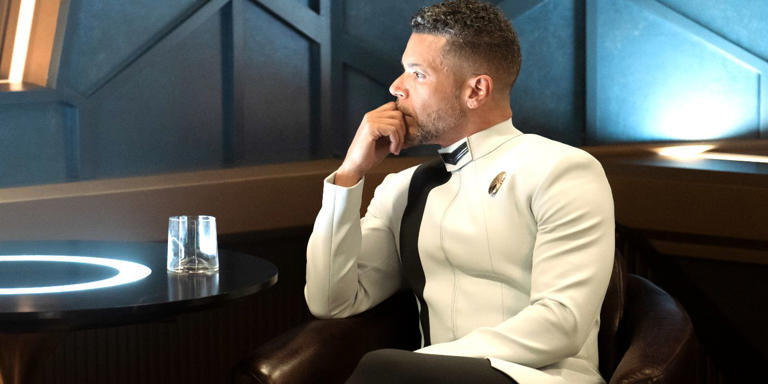

IMAGES
VIDEO
COMMENTS
The series originally aired from September 1966 through June 1969 on NBC. [1] This is the first television series in the Star Trek franchise, and comprises 79 regular episodes over the series' three seasons, along with the series' original pilot episode, "The Cage". The episodes are listed in order by original air date, [2] which match the ...
This is a list of writers for the original Star Trek television series sorted by the amount of episodes written. Collaborations are marked with dashes. (-) Contributions, pseudonyms and episode numbers are noted in parenthesis. Gene L. Coon "Arena" (S01E18) (Teleplay) "Space Seed" (S01E22) (Teleplay - with Carey Wilber) "A Taste of Armageddon" (S01E23) (Teleplay - with Robert Hamner) "The ...
This is a list of writers of Star Trek: The Original Series episodes. Stanley Adams "The Mark of Gideon" Margaret Armen "The Gamesters of Triskelion" "The Paradise Syndrome" "The Cloud Minders" (Teleplay) Jean Lisette Aroeste "Is There in Truth No Beauty?" "All Our Yesterdays" S. Bar-David "Dagger of the Mind" "The Galileo Seven" (Teleplay) Jerome Bixby "Mirror, Mirror" "By Any Other Name ...
Star Trek is an American science fiction television series created by Gene Roddenberry that follows the adventures of the starship USS Enterprise (NCC-1701) and its crew. It acquired the retronym of Star Trek: The Original Series (TOS) to distinguish the show within the media franchise that it began.. The show is set in the Milky Way galaxy, c. 2266-2269.
Melinda M. Snodgrass was born on November 27, 1951 in Los Angeles, California, USA. She is a writer, known for Star Trek: The Next Generation (1987), Odyssey 5 (2002) and Wild Cards. Best Episodes: The Measure of a Man (9.5/10) The High Ground (9.5/10) The Ensigns of Command (9/10) (The Next Generation) 6.
The Great TV Writers: Gene Roddenberry. Eugene Wesley Roddenberry (August 19, 1921 - October 24, 1991) was an American television screenwriter, producer and creator of the original Star Trek television series, and its first spin-off The Next Generation. Suffice it to say, he was one of the most successful writers of his day.
Eugene Wesley Roddenberry Sr. (August 19, 1921 - October 24, 1991) was an American television screenwriter and producer who created the science fiction franchise Star Trek. Born in El Paso, Texas, Roddenberry grew up in Los Angeles, where his father was a police officer.Roddenberry flew 89 combat missions in the Army Air Forces during World War II and worked as a commercial pilot after the war.
Star Trek: The Original Series (referred to as Star Trek prior to any spin-offs) is the first Star Trek series. The first episode of the show aired on 6 September 1966 on CTV in Canada, followed by a 8 September 1966 airing on NBC in America. The show was created by Gene Roddenberry as a "Wagon Train to the Stars". Star Trek was set in the 23rd century and featured the voyages of the starship ...
These excerpts from a 31-page photocopied writers' guide for the original Star Trek series show how early Trek episodes were crafted. The guide, written in 1967, was meant to help writers for ...
Star Trek: Created by Gene Roddenberry. With Leonard Nimoy, William Shatner, DeForest Kelley, Nichelle Nichols. In the 23rd Century, Captain James T. Kirk and the crew of the U.S.S. Enterprise explore the galaxy and defend the United Federation of Planets.
D.C. Fontana (25 March 1939 - 2 December 2019; age 80) was a writer and script editor who had the distinction of being one of the few people to have worked on Star Trek: The Original Series, as well as Star Trek: The Animated Series, Star Trek: The Next Generation, and Star Trek: Deep Space Nine. Deep Space Nine was her favorite Star Trek spinoff. She especially liked the show's strong ...
Star Trek: The Original Series Scripts and Writer's Guides includes scripts and writer's guides from 1965 to 1968, encompassing seasons one to three, which are known as the Original Series. The episodes were written by several authors, and this collection includes annotated scripts and multiple iterations of some episodes. Materials in this ...
Getty Images. Harlan Ellison, the legendary, legendarily irascible speculative fiction writer who died this week at age 84, wrote the greatest episode of Star Trek ever made. And he hated it ...
Ricardo Montaban's single appearance on the original series as the 1990s warlord Khan Noonien Singh set the stage for the undisputed greatest Star Trek film ever, The Wrath of Khan, set 15 years ...
Star Trek has a history of not only highlighting powerful women on-screen, but featuring them behind-the-scenes as well. Going as far back as Star Trek: The Original Series, each series has featured women as episode writers, which was a striking move for a 1960s show.As the franchise continued to grow throughout the years, more women joined the Star Trek writing family, bringing us stories of ...
Naren Shankar - 29 Episodes. Since his time on TNG, Naren Shankar has become a prolific producer on some of TV's biggest hit series. However, early in his career he was a frequent writer and story editor for The Next Generation and contributed some classic tales. Shankar's time on the show coincided with the last three seasons and though the ...
STAR TREK WRITERS/DIRECTORS GUIDE SERIES CREATED BY: THIRD REVISION ... YES, THE STAR TREK FORMAT IS ACTUALLY THAT SIMPLE. IF YOU'RE A TV PROFESSIONAL, YOU ALREADY KNOW THE FOLLOWING SEVEN RULES: I. Build your episode on an action-adventure frame- work. We must reach out, hold and entertain a mass audience of some 20.,000,000 people or we ...
Eugene Wesley Roddenberry (August 19, 1921 - October 24, 1991) was an American television screenwriter, producer and creator of the original Star Trek television series, and its first spin-off The Next Generation. Born in El Paso, Texas, Roddenberry grew up in Los Angeles, where his father was a police officer.
Dorothy Catherine Fontana (March 25, 1939 - December 2, 2019) was an American television script writer and story editor, best known for her work on the original Star Trek series.. After a short period working for Samuel A. Peeples as a secretary, Fontana moved to work for Del Reisman, a producer on The Lieutenant, whose creator was Gene Roddenberry. ...
Star Trek: The Original Series consisted mostly of one-and-done episodes that often had open endings. The show was canceled after only three seasons, so writers didn't often have the opportunity ...
One particularly weak episode of Star Trek: The Next Generation inspired three writers to write their own, much better, episode. Following the adventures of Captain Jean-Luc Picard (Patrick Stewart) and the USS Enterprise-D, TNG took a couple of seasons to truly find its footing.While there were some genuinely great episodes during TNG season 2, there were also a few flops.
T he Star Trek franchise has a straightforward mandate when it comes to making individual episodes. The writers select a science fiction idea with varying levels of grounded realism. Each concept ...
Harlan Ellison (27 May 1934 - 28 June 2018; age 84) was an American author, producer, and writer credited with writing the Star Trek: The Original Series first season episode "The City on the Edge of Forever" (something which is the subject of controversy). In addition to television work, Ellison wrote prose fiction and nonfiction, screenplays, and computer games. Ellison died in his sleep ...
Directed by Jonathan Frakes and written by Ronald D. Moore and Joe Menosky, "The Chase" was a sixth-season episode of The Next Generation, which, according to The Next Generation Companion, was considered in the writers' room the most "Roddenberryesque" episode of TNG at that time. The story itself took cues from Carl Sagan's novel Contact, and ...
Star Trek: Discovery season 5 has 'cut to "The Chase"' from the get-go, and the introduction of intriguing new characters like Moll (Eve Harlow), L'ak (Elias Toufexis), and Commander Rayner (Callum Keith Rennie) have added fascinating new dynamics to the series. Discovery's treasure hunt has allowed the serialized series to also weave-in more stand-alone stories that illuminate the stories of ...
The original "Star Trek" television series, which aired in the late 1960s, kicked off an ever-expanding multiverse of cultural phenomena, with TV and movie spinoffs and conventions where a ...
Jerry Sohl (2 December 1913 - 4 November 2002; age 88) was a science fiction prose writer, who wrote three episodes of Star Trek: The Original Series. For television, he first ghost-wrote episodes of The Twilight Zone for Charles Beaumont, who was suffering from Alzheimers. He used the pseudonym of Nathan Butler for his credit on "This Side of Paradise" because he was displeased with D.C ...
The sight of a Tribble aboard the USS Discovery should be alarming, but Star Trek: Discovery season 5 explained this Tribble is no trouble at all. Written by Kyle Jarrow and Lauren Wilkinson and directed by Andi Armaganian, Star Trek: Discovery season 5, episode 3, "Jinaal" brings the USS Discovery to Trill, where a clue to the ancient treasure of the Progenitors is hidden.
Star Trek is an American science fiction media franchise created by Gene Roddenberry, which began with the eponymous 1960s television series and became a worldwide pop-culture phenomenon.Since its creation, the franchise has expanded into various films, television series, video games, novels, and comic books, and it has become one of the most recognizable and highest-grossing media franchises ...
On The 7th Rule podcast, Star Trek: Discovery season 5, episode 3 co-writer Kyle Jarrow teased the aftermath of Dr. Culber's Trill takeover to hosts Cirroc Lofton and Ryan T. Husk. Jarrow hinted ...